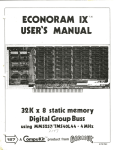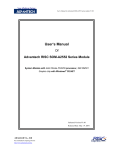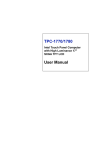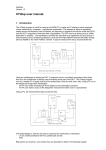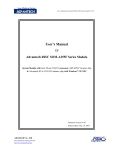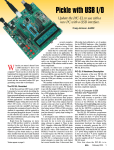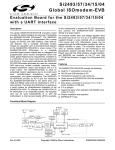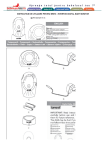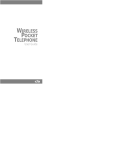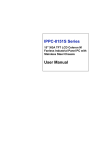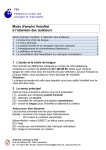Download “QuickieLab” Assembly & User Manual
Transcript
“QuickieLab” Assembly & User Manual … a BASIC Stamp platform for ham radio experiments Figure 1: The QuickieLab is a BASIC Stamp-powered experimenters’ platform with a 16x2 character LCD for data and status display, keypad for numeric data and command entry, general purpose input/output devices (potentiometer, pushbuttons, LEDs, speaker), a frequency counter, A/D and D/A converters, a digital pot and an RS-232 serial port for downloading of Basic program experiments. Provision is also made to accommodate an AD9850 DDS DaughterCard, separately available from the NJQRP Club. The Stamp’s sixteen input/output pins may be jumpered to an “experimenter’s plugboard” for temporary addition of circuit components that work with the downloaded software in the BASIC Stamp to perform the experiments. [A prototype PC board is shown here. The production version is soldermasked and silkscreened to assist in assembly.] INTRODUCTION bed for experimentation, measurement and simple control. Further, we thought it would be great if this experimenters’ platform were tightly coupled with the string of “N2CX Quickies” presented in each issue of QQ magazine. This would provide Joe with a computing module to help illustrate his points and the readers with a quick and easy way to reproduce the Quickie material. Hence the name of this project was born … the QuickieLab. Great feedback is regularly received now from readers on the latest string of microcomputing projects in QRP Homebrewer and QRP Quarterly magazines. It’s very gratifying and encouraging to know that many QRPers are interested in these digital projects. When considering even more useful projects that QRPers can easily build right now, the light bulb clicked on once again over a lunch with Joe Everhart, N2CX. We decided then that a perfect project would be one that provides a reusable test QuickieLab Assembly & User Manual, v1.0 1 Copyright 2003, G. Heron N2APB THE BASIC STAMP As mentioned, a number of common I/O devices are provided on the QuickieLab board for use in the various experiments. Three pushbuttons and three LEDs are provided for simple input and output controls and indicators. Sometimes the most instructive experiment is to press a button and see a corresponding LED be illuminated under program control. A built-in potentiometer is provided and is quite useful as a control that delivers a continuously variable 0-255 binary input to the Basic program. A program can read the pot and adjust a software algorithm based on the specific setting. A simple D-to-A converter is provided to produce a DC voltage from 0-to-5V for controlling other hardware under software control. And lastly, a speaker is provided to enable the Basic program to output an audio tone that can range from 200 Hz up to 10 KHz. Can’t you just imagine a an upcoming Joe’s Quickie application using this speaker to produce an audio dip when measuring SWR?! The QuickieLab is a 4.5” x 6” printed circuit board with keypad, LCD, switch input and LED output capabilities built around the popular BASIC Stamp processor from Parallax.inc. The Stamp was selected because of its easy to program BASIC language and its simple hardware interface – just connect +5V to this Stamp chip and you can download a BASIC program from your PC to wiggle the output pins and read the input pins as desired. Readers wishing to follow along with N2CX and his BASIC language experiments could certainly purchase one of the many fine Stamp -based experimentation boards from Parallax.com and have a ready-to-go hardware platform with most of the capabilities described here. However, one could save quite a few pennies by building the QuickieLab from the plans in this article and end up with a more capable platform that is specifically geared to the Joe’s Quickie experiments coming in future installments. Each of these built-in I/O devices is wired to a specific I/O pin of the Stamp through pinheader P1. When the corresponding pins of P1 are jumpered with configuration blocks, the respective signals are wired directly to I/O pins on the Stamp. In this way you could easily configure the QuickieLab to use its built-in components for experiments without necessarily using additional components on the plugboard. When a given built-in I/O device is not needed for the current experiment, its pins on P1 can be left open and the Stamp’s I/O pin on J10 may be jumpered over to something else on the plugboard. Refe rring to the schematic, you can see that the QuickieLab is based on use of a BASIC Stamp microcontroller. The Stamp merely needs to be powered with 6-to-12V dc from the QuickieLab’s connector J1 and this self-contained “system on a chip” is ready to go. It contains an onboard 5V regulator for its computing logic and its own RS-232 levels for serial port connection to a PC. Further, the Stamp contains an internal non-volatile memory that allows retention of the software program even after power is removed. With this capability the QuickieLab can be programmed once (i.e., it’s software program needs only to be downloaded once from the PC), and it can forevermore operate independent from the PC umbilical cord. Take it out to the field with an appropriate battery supply or to your buddy’s house and it’ll operate the same as it last did on your bench! I/O EXPANDER Perhaps the most attractive feature of the QuickieLab, as compared to commercially-available Stamp boards, is the custom-designed I/O expansion processor U2. Readers of the Digital QRP Homebrewing column in QQ will recognize the SX-28 microcontroller used for I/O expansion here as also being used in the PSK31 Audio Beacon and Badger smartbadge projects. This time I programmed the SX-28 to enhance the QuickieLab by having it serve as an intermediate processor that helps in the input and output of some additional built-in components. The IOX project website provides complete details on interfacing and using the I/O Expander, but here’s a quick overview of the function provided in this versatile controller. I/O PINS DO ALL THE WORK The main purpose of any microcontroller is to input various signals, do some computations based on those signals, and then output other signals based on those computations. Thus the Stamp’s 16 I/O pins are of great interest and utility to us in the QuickieLab. Each of the I/O pins is under software control and can be used to read the state of pushbuttons and keypad actuations, as well as to send data to human-readable devices like the LEDs and the LCD. The I/O pins are wired to a jumper block J10 located directly above the plugboard and the user may jumper any of them to components placed on the plugboard. In this way, the components called out in the experiment may be temporarily “wired” to the Stamp and controlled by the software program. For example, you could mount a diode, resistor and a couple of capacitors on the plugboard, jumper the output of that network to the built-in A/D converter (see following section) and have yourself a rudimentary-but-useful RF voltmeter. Of course you’d have to have the Voltmeter software loaded on the Stamp from the N2CX Quickie website – Joe intends on having many such software programs and application notes available for the QuickieLab. QuickieLab Assembly & User Manual, v1.0 Serial LCD Display Driver – The SX-28 accepts serial commands from the BASIC Stamp to display the specified ASCII character directly, or a command character to control the cursor position and other LCD functions like clear display and scroll control. The SX-28 duplicates the simple command structure found in other “serial LCD” controllers, allowing the QuickieLab programmer (i.e., you) to easily display messages to the LCD display. You can clear the display, home the cursor, control scrolling and blinking, and simply display characters all by means of a serial output command from the BASIC Stamp software you’ve written. Frequency Counter – Another unique feature of this I/O Expander chip is its ability to measure frequency. Since this fast SX processor is sitting idle most of the time waiting to be commanded by the Stamp to display characters, I dropped 2 Copyright 2003, G. Heron N2APB in a tried-and-true software routine that samples the signal on the RTCC pin and determines its frequency. Thus when the Stamp commands a frequency measurement, the SX processor sends back certain data that represents the frequency of the input signal up to 30 MHz. This is a pretty useful feature for a QuickieLab such as ours! follow that may help you assemble the components to the PC board. IC sockets should be used for all integrated circuits. Single in-line 0.1”-spaced female sockets are used throughout the PC board to provide “patchable access” between the various signals and the additional components that you will plug into the experimenter’s plugboard. These female sockets are also used to connect the LCD and keypad modules, which are held up off the board with standoffs and plug into connectors on the PC board to facilitate easy access to components beneath them during the construction and test phases. The strips are purchased in 36- or 72-position lengths and must be snipped off to create the individual pieces for each connector. When snipping off a length of the strip, you will likely lose (destroy) one position and need to file down the rough end to make it a clean edge. Alternatively, a fine-tooth hobby saw may be used to create the individual pieces without losing a connector position in the process. A-to-D Converter – Since it is important in most of our ham experiments to read an analog voltage of some sort, we felt it would great to add a simple 8-bit A/D converter as part of the built-in arsenal of components. The I/O Expander interfaces to the ubiquitous ADC0831 chip and the BASIC program in the Stamp can issue an ADC command instructing the analog conversion to be done. The 8-bit value is then returned to the Stamp controller for possible computation and display. Keypad – Yet another important I/O component contained in the I/O Expander chip is that of the software driver and hardware interface to a keypad. Useful for numeric and command entry, this 4 row x 3 column matrix keypad is constantly scanned by the SX controller. Whenever a keypress is detected, a message is sent to the main BASIC program in the STAMP controller and specific action can be taken. In this way, the programmer (i.e., N2CX with his application note software, or you with your own software experiment) may input data, set frequencies to be later output, etc. Stamp I/O signals socket -- The socket strip containing the Stamp I/O pin signals is located directly to the left of the plugboard to allow the user to easily place a wire jumper from any given BS2 signal to a component on the plugboard. Built-in I/O Header -- Jumpers placed along a dual row 0.1” pinheader to patch in the built-in IO devices located above the plugboard. Digital Potentiometer – The final built-in I/O device controlled by the I/O Expander is a non-volatile “digital potentiometer”. This device is essentially an electronic pot that can be adjusted under program control to move its wiper to be at any of 100 positions. If, for example, this digital pot were jumpered into the feedback loop of an op amp on the plugboard, your BASIC Stamp program could output a command to the I/O controller to adjust the pot up or down to change gain of the amplifier stage. This is a pretty neat capability to have in our experimenter’s platform! Speaker -- The thin, 16-o r-32-ohm speaker is glued to the bottom side of the PC board and its leads are soldered to the noted pads. Rubber feet should be attached to the bottom of the PC board to allow it to stand comfortably on your work table when in use. LCD – The QuickieLab PC board was layed out using a popular 2x16 LCD from BG Micro. This part was very inexpensive and in large supply at the time of the kit design. However from time to time, specific discount/surplus parts may be temporarily unavailable and a homebrewer may need to use displays from other manufacturers. In general any 2x16 or 2x20 character LCD that uses the HD44780 controller and has a 4-bit interface available will functionally work with the QuickieLab board and software. Other manufacturers’ display form factors will likely be different and you will need to make up a simple 10-wire harness to connect the display to the appropriate pads on the board connector J13. Just adapt your specific display to the QuickieLab and you’ll be in business! DDS DaughterCard – Provisions are made on the QuickieLab to accommodate the newest addition in the HC908 Digital Breadboard project family - a DDS daughtercard. This small board contains the AD9850 Direct Digital Synthesis chip, its oscillator and the low pass output filters that all conspire to produce very precise and low-noise frequencies from the sub-hertz basement up to 30 MHz. The 1”x 2” daughtercard plugs into socket J6 on the QuickieLab and enables the homebrewer/programmer to generate a very precise and accurate signal source. It can be useful as a VFO, a test signal source, a local oscillator in a test receiver or even as an audio oscillator when patched into the built-in speaker on the QuickieLab. Voltage Regulator VR1 – If you use the heatsink (recommended), it would be good to drill a 1/8” hole at the marked location and screw the heatsink and VR1 combination to the pc board. You should also use thermal grease between VR1 and the heatsink, as this will ensure a good thermal connection and give you the widest safety factor for power dissipation. CONSTRUCTION Building up the QuickieLab is straightforward. The list of parts is provided in this manual and components are easily acquired from Mouser Electronics, Dig -Key and the NJQRP Club. You might even have some of these common parts already in your own junkbox. Assemble all components on the PC board by carefully following the Parts Layout diagram. Some specific notes QuickieLab Assembly & User Manual, v1.0 3 Copyright 2003, G. Heron N2APB Potentiometer R10 – You can use any mini pot for this component. Just glue it to the board and wire its three connections to the respective pads nearby the component. Any implementation of a Stamp microcontroller might be seen as an expensive computing solution. The BASIC Stamp starts out at $49, and the other components add up from there. A complete QuickieLab might well cost the homebrewer over $100 by the time it’s completed. But “expensive” is a relative term and some homebrewers will likely see this investment as valuable in terms of its educational and long-time reusable nature. ERRATA 1) “J12” was inadvertently used as the reference designator for two connectors: the Keypad and the Digital Pot. 2) Pin 1 of the LCD connector J13 was inadvertently left ungrounded. You should ground this square pad by placing a short jumper on the bottom side of the board from from the pad to the grounded side of the trim potentiometer next to it. The QuickieLab is not a performance-oriented or extensible microcomputing platform. A very limited number of I/O pins limits how many hardware components can be connected at one time. Further, the effective speed of the Stamp is significantly slower than the HC908 Digital Breadboard project or any other native-language PIC processor, mainly because the Stamp interprets its high-level BASIC commands individually at run time, greatly slowing down its overall computing process. In contrast, the HC908 Digital Breadboard project is a far better choice for a flexible and dedicated high-performance control and measurement piece of equipment for your bench. USING THE QuickieLab The QuickieLab is first and foremost based on the BASIC Stamp. The vendor of this ingenious device (Parallax.com) provides an excellent development suite to support hobbyists in their programming and use of the Stamp. When you purchase the microcontroller from Parallax, you can request a CD-ROM containing software for your PC that allows you to create/modify your BASIC programs and download them to the Stamp contained on the QuickieLab. Otherwise, all software contained on the CD-ROM is also available for free download from their Stamp web pages at www.parallax.com. However even with these limitations, the QuickieLab is a great educational solution for quick-and-easy experiments that don’t require lots of high speed operations. N2CX regularly tells me how utterly cool it is to be able to program an algorithm into the QuickieLab and see immediate results. Parallax “PBASIC” commands are tailored to real time control of simple hardware devices and there are many useful extensions to the language which are of great value to homebrewers. The CD-ROM also contains many sample programs illustrating basic operation of the commands and chip features. Any way you look at the QuickieLab, it’s easy to build, fun to use and you can bet that we’ll be seeing lots of applications for it in future “Joe’s Quickies”. And for starters, have a go at the “Audio Voltmeter” application elsewhere in this issue! You can quickly test your assembled QuickieLab by running a BASIC software program provided on the project website. This “QuickieLab Monitor Program” exercises most of the board’s features and customizing the Monitor program is an excellent starting point for you in making your own programs and experiments. PARTS LIST BASIC Stamp IC – U1 www.parallax.com I/O Expander IC – U2, Y1 resonator & PCB – NJQRP Club A/D converter, – U3, Digi-Key ADC0831CCN- ND NV Trim Pot IC – U4, Digi-Key DS1804-100-ND LCD – 16x2 character LCD, BG Micro MDL 16264, www.bgmicro.com Keypad – 4 row x 3 column, Digi-Key GH5001-ND Plugboard – Radio Shack 276-175 RS-232 DB9F connector – J5, D-style, Jameco 104951 Coaxial power connector – 2.1mm , P3, Mouser 163-5004 BNC jacks – J8, J9 , Mouser 523-31-5538-10-RFX Voltage regulator – 1A 5V, VR1 , Mouser 511-L7805 ABV Heatsink – Mouser 532-577102B00 Pushbutton (4) -- PB1,2,3,4 – Digi-Key P8075SCT- ND SIP sockets – J2,3,4,6,7,10,11,12, Mouser 517-974-01-36 Pinheader – 2x12 pinheader, P1, Mouser 517-6121TN Jumper shunts (16) – 0.1”, Mouser 571-3828155 Speaker – 32-ohm, Mouser 65-AT-42 or RS p/n 273-0093) Transistor – 2N4401 transistor, Q1, Mouser 512-2N4401 LED (3) – Digi-Key 160-1104-ND Capacitor – 4.7pF disc, Mouser ____ Capacitor – .0022uF disc, Mouser _____ Capacitor –.1uF mono, Future-Active SR215E104MAA Capacitor – 1uF electrolytic, Mouser 140-XRL50V1.0 Capacitor – 10uF electrolytic, Mouser 140-XRL16V10 IC socket (2) – 8-pin, Mouser 575-193308 IC socket – 24-pin, Mouser 575-193624 IC socket – 28-pin, Mouser 575-193328 Potentiometer – 10K-ohm, Mouser 31CW401 or 317-2090-10K Trim Pot – 10K-ohm, Mouser 72-T93XA-10K Resistor – 220-ohm, Mouser 291-220 Resistor -- 470-ohm resistors (3) – Mouser 291-470 A Users Manual is provided in PDF format on the Parallax CD to guide first time users through typical BASIC program creation and debug sessions. A complete PBASIC language guide is also in the Users Manual for detailed use as a programming reference. With all this neat development stuff provided by Parallax, you can easily have your QuickieLab up and running within an hour. All you then need to do is download the specialized QuickieLab Application Notes from the project website (www.njqrp.org/quickielab), send that specific BASIC program to your QuickieLab and you’ll be able to keep right in step with N2CX when he comes out with the next “Joe’s Quickie” in the pages of QQ. Any convenient source from 9V to 12V may be used to power the QuickieLab. The supply current is only about 85ma, so even battery operation is feasible. LIMITATIONS The BASIC Stamp as a microcontroller and the QuickieLab as an experimenter’s platform each has great potential for instruction and utility on your workbench. However I’d be remiss not to caution readers about some limitations. QuickieLab Assembly & User Manual, v1.0 4 Copyright 2003, G. Heron N2APB Resistor – 1.5K-ohm Mouser 291-1.5K Resistor – 2K-ohm, Mouser 291-2K Resistor – 10K-ohm, Mouser 291-10K Resistor – 100K-ohm, Mouser 291-100K 4) Read all about the BASIC Stamp at the Parallax.com website (www.parallax.com). All software, application notes and documentation are free for the download, and great fun can be had while perusing this vendor’s website. NOTES 5) Questions concerning the QuickieLab may be directed to George Heron, N2APB ([email protected]) or Joe Everhart, N2CX ([email protected]). We’ll do our best to help you out as soon as possible. 1) The QuickieLab was designed by George Heron, N2APB. Copyright 2002 by George L. Heron. All rights reserved. 2) The QuickieLab project website can be found at www.njqrp.org/quickielab. It contains more detailed construction and test information, color photos, I/O Expander source code, BASIC Stamp sample programs, QuickieLab application notes, and a complete listing of I/O Expander commands and control characters. 6) Peter Anderson sells a “BS2 Homebrew Kit” that can be used with the QuickieLab PC board. You can find details of this at: www.phanderson.com/stamp/bs2_homebrew.html. This 3-chip set of parts is about half the price of a BASIC Stamp 2 chip. 3) The I/O Expander IC and Resonator may be purchased from the NJQRP Club. See www.njqrp.org/iox for ordering details. QuickieLab pc board layout QuickieLab Assembly & User Manual, v1.0 5 Copyright 2003, G. Heron N2APB









